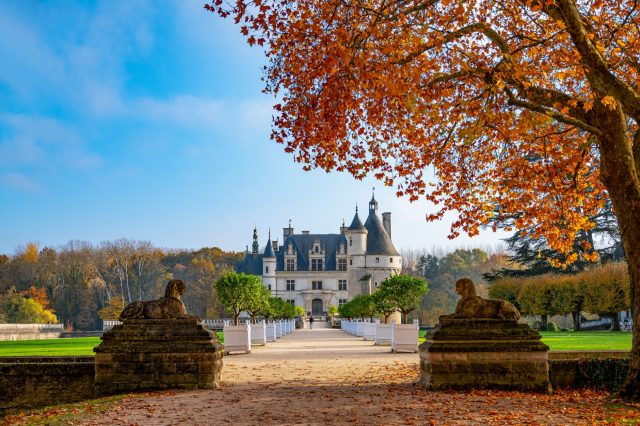Are destination shows back? If you ask Chanel, which took out the Château de Chenonceau for this year’s Métiers d’art show, the answer is a resounding yes. In the Loire Valley, Virginie Viard paid homage to the powerful women who have inhabited the castle since the Renaissance.
The show took place in the Château de Chenonceau
If the recent season of The Crown made you wonder how you’d fare when put to the “Balmoral Test”, imagine how you’d dress for Château de Chenonceau. It was the challenge Virginie Viard set herself for this year’s Métiers d’art collection, which also marked Chanel’s return to destination shows after a series of Paris presentations. Staged without an audience – save for Kristen Stewart, who had the whole place to herself – models were captured on film wafting down the bridge gallery of the medieval bastion in the Loire Valley like the ladies of a noble court, floating through time and space. “It’s between the past of Chanel, and today, and tomorrow, through Virginie’s vision,” Bruno Pavlovsky, the president of fashion at Chanel, said on video call.
Virginie Viard paid tribute to the castle’s female residents
There was a certain – no doubt intentional – irony to the choice of location. Following a year spent confined to our personal spaces, a castle signifies the ultimate upgrade when “working from home”. It’s a reality that has spawned the marketing trend of “comfort-wear”: the idea that we innately dress down and more comfortably when we don’t have to be seen in public. That notion wouldn’t have flown in the day of Catherine de’ Medici and Diane de Poitiers, two of many powerful and politically ambitious women who inhabited Château de Chenonceau since it was erected in 1522. Known as the Château des Dames – the Ladies’ Castle – this made it the perfect setting for Viard’s new female-led era of Chanel, which – by the way – shows no intention of dressing down. “She is a woman designing for women. We see that in the collections, and we see that in the boutiques with our customers. There is something very special there that only a woman can give a woman,” Pavlovsky said.
The collection featured indirect nods to the Renaissance
In an article from 1936, Coco Chanel wrote about her affinity for Renaissance women. “I have always been struck by a strange feeling of sympathy and admiration towards the women who lived from François Ier to Louis XIII, perhaps because I find them all to be great, with a magnificent simplicity and a majesty imbued with onerous duties.” It would have been easy for Viard to go all in on the reference, but nearly two years into the job, it’s clear that she doesn’t approach a theme as directly as her teacher, Karl Lagerfeld, sometimes did. Rather, her Métiers d’art collection paid gentle nods to the Renaissance wardrobe and brought it into the present. Cut into her silhouette was the memory of the era’s rigorous edges, strapless shoulders, floor-length skirts, bell sleeves, and ruffled gloves. She paid homage to some of the trademarks of the era in a veiled cone hat, latticework on dresses, a leather jacket quilted with pearls, and knitwear that resembled the chainmail of armour. Those pieces – painstakingly constructed – were a treat for the artisans to whom the Métiers d’art line is devoted.
It was an optimistic look to the future
The show signified a return to destination shows
Read Next
The Location Of Chanel’s Métiers D’Art Show Is Steeped In Feminist History
Editor
Anders Christian MadsenCredit
Lead image: Courtesy of Chanel

